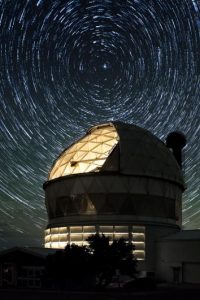
FORT DAVIS, Texas — The world’s third-largest telescope, the 10-meter Hobby-Eberly Telescope (HET) located at McDonald Observatory in West Texas, has completed a multiyear $40 Million upgrade. The upgrade will enable researchers to take on the biggest challenges in astronomy today: unraveling the mystery of dark energy, probing distant galaxies and black holes, discovering and characterizing planets around other stars and much more. The HET Board is celebrated with a dedication ceremony on Sunday, April 9.
“The entire Board, as well as the HET astronomy community, are excited about the telescope upgrade and the new science it will enable,” said Dr. Larry Ramsey, Chair chair of the HET Board and professor of astronomy at Penn State. “The upgraded HET will conduct the first major study of how dark energy changes over time, and we all look forward to new and exciting results in this area and others.”
HET’s upgrade included a variety of aspects. The telescope’s field of view has been expanded to 70 percent of the diameter of the full Moon and now views an area of sky 120 times larger than before. And HET now sports an innovative new set of optics. “The Harold C. Simmons Dark Energy Optical System is one of the most complex optical systems ever deployed in astronomy,” said McDonald Observatory Director Dr. Taft Armandroff of The University of Texas at Austin. The Simmons System rides on the telescope’s new tracker, or “top end,” which enables tracking and guiding on cosmic targets.
A practically new telescope deserves a new set of instruments to make the most of its capabilities. Astronomers and engineers have built a suite of four instruments, each optimized for a different kind of research, for the new HET. (See appendix for details.)
The upgrade is an integral part of the upcoming Hobby-Eberly Telescope Dark Energy Experiment (HETDEX), a four-year project starting later this year that will study dark energy, the mysterious force causing the universe’s rate of expansion to speed up. This survey will look back 11 billion years and determine if dark energy has changed over time.
The HET was originally dedicated in 1997. It is a partnership between The University of Texas at Austin, Penn State, and two German institutions, Georg-August-Universität Göttingen and Ludwig-Maximilians-Universität München.
Sunday’s event welcomed Texas elected officials, philanthropic donors, leadership from The University of Texas at Austin and Penn State, officials from the National Science Foundation and scientists. The telescope upgrade was funded by a combination of federal, state and private sources.




